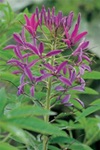
Today I’m working on a project that requires the plants I’m writing about to be organized alphabetically, by common name.
This quickly turns up two big problems:
1. What is the correct common name for the plants I need to include?
2. Some entirely different plants share the same common name.
In Britain, common names are used far less than they are here in the US – and very often they’re different. And in different parts of North America, different common names can be used for the same plant. So I turn to the USDA Plants Database, which gives common names for native and introduced plants, even for many rarely seen species.
I need to check Cleome. In Britain, we tend to call the various forms of that impressive tall annual Cleome hassleriana – well, we tend to simply call them Cleome… or perhaps occasionally Spider Flower. But, not very helpfully, Spider Flower is a name also used for those Australian shrubs, Grevillea. OK, confusion is unlikely, but if the plants are listed by common name, the varieties of Cleome and Grevillea – two entirely unrelated plants – would be listed together as Spider Flower as if they were forms of the same plant. Not helpful.
But the USDA Plants Database turns everything upside down by revealing that in North America the common name for Cleome hassleriana – is Pink Queen. Now, there’s a popular old heirloom variety of Cleome hassleriana called ‘Pink Queen’. So we’re in the bizarre position of having to list this plant as Pink Queen ‘Pink Queen’… And not only is there also Pink Queen ‘Purple Queen’ but Pink Queen ‘White Queen’ and Pink Queen ‘Violet Queen’. Makes no sense at all.
Botanical names may sometimes turn out to be tongue-twisters – but Pink Queen ‘Purple Queen’? I don’t think so.

Source: Transatlantic Gardener – Botanical Names Really are Easier than Common Names – Graham Rice





